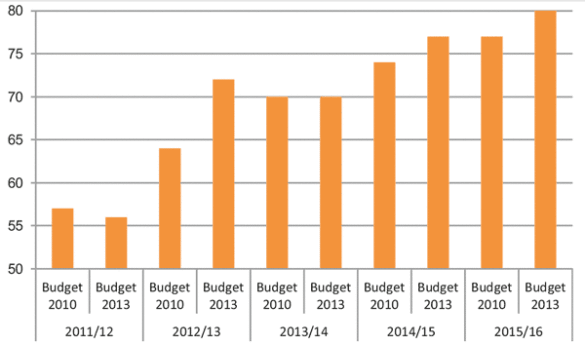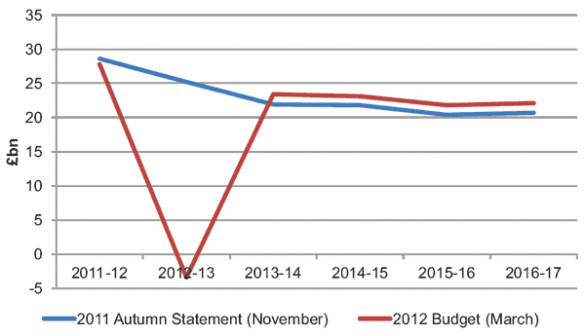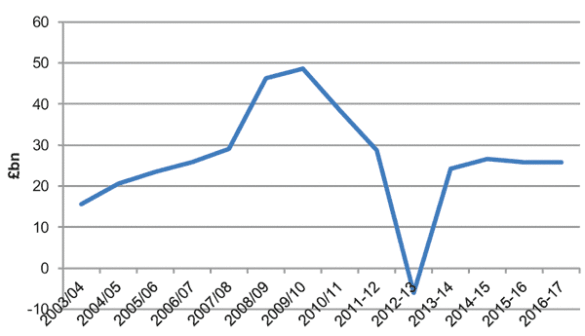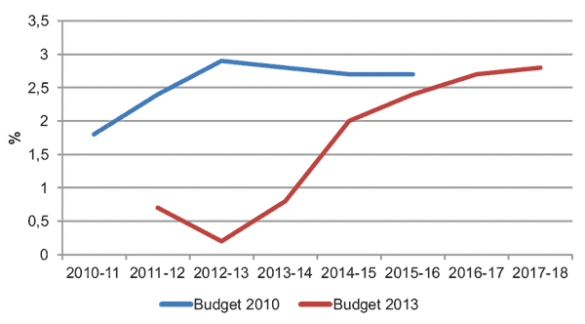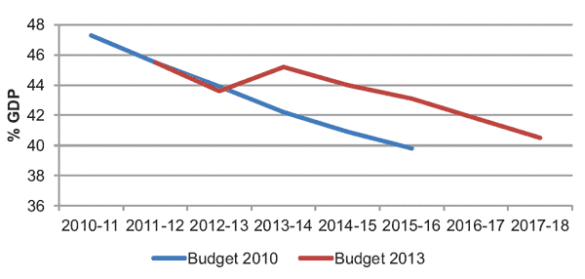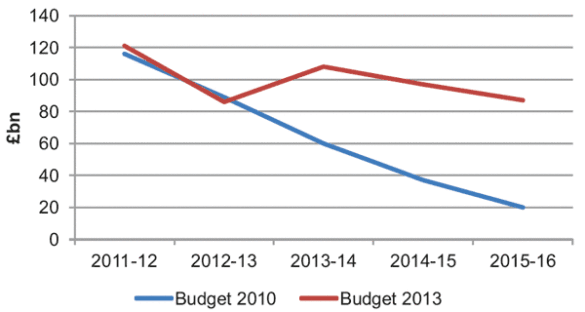The government is embarking upon a programme of fiscal consolidation, though delivering the reduction in the government’s deficit has not been as successful as it hoped. The fiscal consolidation was largely achieved through tax increases in the early years. Government spending remains very high as a proportion of national income. At the same time, with very little room for manoeuvre given the decision not to cut government spending faster, the government is trying to cut some tax rates. In particular, the level of earnings at which individuals start to pay tax has risen and the corporation tax rate is falling.
The tax system in the UK is very complex and, especially when combined with the impact of the benefits system, some very unfortunate results are achieved when it comes to work incentives and incentives for saving and family formation.
Tax policy
There has been a general move by the coalition government to increase the level of earnings at which individuals start to pay tax. In 2009-10, individuals paid tax once their earnings reached £6,475. In 2013-14, they will not pay tax until their earnings reach £9,440 and that level will be increased to £10,000 in 2014-15. At the same time, the government has changed other tax thresholds to ensure that those earning around £40,000 a year or more do not benefit from some of the annual increases in the point at which individuals start to pay tax. Between 2012-13 and 2013-14, the income level at which higher rates of tax will be paid has actually been lowered by £1,025. This policy of gradually pulling more people into higher rates of tax simply exacerbates a long-running trend. Between 1979 and 2010, the bottom of the higher rate tax band fell by 42 per cent in earnings-adjusted terms and by nearly 10 per cent in real terms. The further big falls in the level of income at which higher rates are paid since 2010 has had dramatic effects and, in just five years, the number of higher-rate taxpayers will increase by about two-thirds. In the UK, “bracket creep” is happening, not just because of rising real incomes but because the brackets themselves are creeping downwards.
More generally, income tax policy is very haphazard in the UK. Whilst the number of taxpayers has been reduced, the government has tried to raise more revenue from the falling number of people paying income tax. Not only has the income level at which higher-rate tax is payable fallen, but there is now a special rate of tax above the 40 per cent rate (though this is reducing from 50 per cent to 45 per cent) and there is a strange 60 per cent effective tax rate on £13,000 of earnings starting at £100,000 when the personal income tax allowance is withdrawn. This is a clear disincentive to promotion and progression and creates more complexity in the system.
Employees and employers also pay national insurance contributions (a social security tax). This system is very complex as a result of reforms undertaken by the previous administration. The UK has a rather limited set of social insurance benefits and the criteria for accruing these benefits are quite straightforward. However, we have a very complex system of payroll contributions to finance these benefits. For employed people, there are five different thresholds that determine the income levels at which contributions are paid and benefits accrue. Broadly, employees and employers pay a payroll tax of 12 per cent and 13.8 per cent respectively on all earnings from £7,748-£41,443 per annum (2013-14). Employees’ contributions fall to 2 per cent once an earnings level of £41,444 is reached, but employers’ contributions continue at the rate of 13.8 per cent. Given that none of the UK social insurance benefits are earnings related – they are all flat rate – this is a remarkably complex system of graduating contributions. There has been some political pressure to merge the tax and national insurance systems given the confusing nature of the UK system. However, there is also opposition to this. Some see the retention of a contributory national insurance system as an important principle that is worth preserving. There are also practical problems in merging income taxes and social security taxes given that workers above state pension age do not pay national insurance contributions and there are reduced rates for the self-employed and much lower contributions for those with several jobs (because the annual allowance is per job and not per person).
The government also announced in the 2013 budget that the UK’s state pension systems will be replaced by a single system providing a pension of about £144 a week and that the proposed reform will be accelerated to 2016. Currently, the self-employed do not receive one of the state pensions and this explains why they pay lower national insurance contributions. The incoherent UK national insurance system will probably be even more difficult to justify when the pension reform is implemented.
Over the last few years, the government has also been phasing out the concept of “contracting out” of national insurance pensions. For fifty years, one of the features of the UK social security system was that those who provided themselves with a funded private pension could pay lower national insurance contributions and receive a lower state pension. This form of voluntary privatisation of social has now been phased out for individuals with their own personal pension scheme and will be abolished for members of company schemes when the new state pension is brought in. The Conservative government is therefore bringing to an end arguably one of the most important welfare part-privatisations in the post-war settlement in Europe so that welfare provision will be even more dominated by the state in the future.
The UK also has a very complex system of so-called tax credits given to both pensioners and people of working age. The system is especially comprehensive for working age families with children. Whilst called tax credits, the payments are really means-tested benefit payments. Because they are means tested, their withdrawal leads to an extraordinarily high level of effective marginal tax and benefit withdrawal rates for families with children. For every extra pound an individual earns, many families lose around 70p or more in income tax, national insurance and lost means-tested benefits. The following table (reproduced from an article by Philip Booth on – http://conservativehome.blogs.com/platform/2012/05/philip-booth.html) shows the tax and benefit withdrawal rates facing a singlee-arner family with three children in 2012-13 at different levels of earnings. The picture has been made more complex by the withdrawal of a benefit that was previously universal (child benefit) on those earning over £50,000 a year.
The figures ignore the withdrawal of council tax benefit, housing benefit and the impact of employer’s payroll taxes and indirect taxes. The coalition government promised to bring forward a measure to allow tax allowances to be transferable between husband and wife to reduce the penalties faced by single-earner couples and reduce the bias against couples in the tax and benefits system. So far there has been no sign of that measure being brought forward. Overall, the UK’s system of family taxation and benefit provision is horrendously complex and corrosive of incentives. There is a strong case for abolishing many of the benefits and bringing in a simple household tax allowance based on the number of adults and children in a household as happens in some European countries.
| Earnings band | Total marginal tax and benefit withdrawal rate |
Income tax | National insurance | Benefit withdrawal |
| £6,420-£7,592 | 41% | 0% | 0% | 41% |
| £7,592-£8,105 | 53% | 0% | 12% | 41% |
| £8,105-£38,798 | 73% | 20% | 12% | 41% |
| £38,798-£42,475 | 32% | 20% | 12% | 0% |
| £42,475-£50,000 | 42% | 40% | 2% | 0% |
| £50,000-£60,000 | 67% | 40% | 2% | 25% |
| £60,000-£100,000 | 42% | 40% | 2% | 0% |
| £100,000-£116,200 | 62% | 60% | 2% | 0% |
| £116,200-£150,000 | 42% | 40% | 2% | 0% |
| £150,000+ | 47% | 45% | 2% | 0% |
The problems in the UK tax and benefits system are illustrated by the OECD’s calculation of the “low wage trap”– this is the loss of income through the tax and benefits when a family’s income rises from 33 per cent to 67 per cent of the average private sector wage. This figure is 79 per cent in the UK.
Business taxation
There was an important announcement about business taxation in the 2013 budget. The rate of corporation tax is to be reduced to 20 per cent – the same rate as the basic rate of income tax. An IEA paper called for this particular reform in 2012 and it appears that much of the reasoning used in that paper has been used by the government. The move will allow some simplification through the abolition of the smaller companies’ regime because smaller companies currently pay corporation tax at the same rate as the basic rate of income tax and it should be possible to abolish some other special schedules too. As well as reducing the tax burden on companies, the move will also reduce the tax bias against equity finance in the UK tax system. Overall, this is a very positive move.
The reduction in the corporation tax rate is going to be phased in. The corporation tax rate for 2013/14 will be 23 per cent, for 2014/15 21 per cent and 20 per cent from 2015/16. The UK has the longest tax code in the developed world. Whilst length of tax code does not necessarily automatically translate into complexity, our corporate tax system is also extremely complex. The government has said that it wishes to simplify the system. However, the actual policy moves – except for the reduction in corporation tax – have been quite different from the declared policy. A number of special reliefs from business taxation have been created in recent years (for example, special treatment of profits from patents) and more were announced in the 2013 budget (for example, special reliefs for the purchase of low-emission vehicles and the use of energy-saving technologies, the extension of tax credits for research and development, and allowances for investment).
Fiscal consolidation
When the present coalition government was formed in 2010 it identified fiscal consolidation as its economic priority. Policy responses to the 2008/09 financial crisis have led to the largest post-war deficit and the intention was to steadily eliminate this by the end of 2015/16. The government proposed a number of spending cuts and tax rises in order to achieve this goal, but have struggled in their ability to follow through.
The original intention was for the majority of the consolidation to come from spending cuts, but because tax rises have a more immediate impact they were favoured early on. The chart below compares the 2010 plan for fiscal consolidation, with the actual results achieved up to 2012/13 as reported in the 2013 Budget and the 2013 Budget plan for future years:
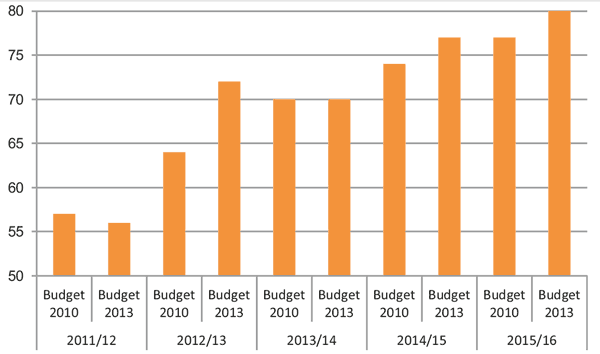
Spending as a % of consolidation
Just 57 per cent of the intended consolidation in 2011/12 was through spending cuts, and the reality was even lower. Increases in VAT and capital gains tax accounted for much of the consolidation. The original plan was for spending cuts to gradually take on a larger share of the consolidation, reaching 77 per cent in 2015/16. However in 2012/13 spending cuts already accounted for 72 per cent of the consolidation, as opposed to the planned 64 per cent. This was expected to fall back to 70 per cent in 2013/14, before rising again to hit a 2015/16 target of 80 per cent. The plans delivered the worst of both worlds – consumer confidence was weakened both by planned spending cuts, and actual tax rises.
The reason why the outturn has been as shown above is not because the government has been more stringent on public spending than it planned in the first few years of fiscal consolidation. It is because tax revenues have not risen as expected as a result of the absence of economic growth. Because tax revenues have not risen, the amount by which the deficit has fallen is smaller and so the spending cuts are a bigger percentage of a smaller level of deficit reduction.
Cuts to public investment
The source of the spending cuts in 2012/13 was a dramatic fall in the amount of public sector net investment (gross investment less depreciation). This can be seen most starkly by comparing the forecast for net investment from the November 2011 Autumn Statement with the March 2012 Budget.

Public sector net investment
However, this focuses on a fairly narrow time period. If we look at public sector net investment (PSNI) from 2003-04 we see the following:

Public sector net investment
The drop in 2012/13 remains dramatic, but it is important to realise that from 2014/15 PSNI is forecast to be £26.6bn, which is the same level as 2007 (i.e. immediately prior to the crisis). Taking the peak of PSNI as the reference point is misleading because the UK had a £20bn fiscal stimulus in 2009 that deliberately brought forward some capital spending from 2010/11. In other words part of the reason for the slump is a prior boom.
Increases in government spending
It is dangerous to read too much into the drastic decline in public sector net investment and government spending more generally. There have been various one-off adjustments. Items such as the transfer of Royal Mail pension plan to the public sector; the sale of Olympic tickets; proceeds of 4G spectrum licenses; and cash transfers from the Bank of England’s Asset Purchase Facility (APF) have all made it hardy to identify the path of government spending. These types of accounting tricks can undermine the credibility of consolidation. “Total managed expenditure” (TME) is the sum of “public sector current expenditure” and “Public sector gross investment”. The 2012/13 dip is possibly at least partly being explained by special factors. Despite this, TME is forecast to grow from 2011/12 – 2017/18. The chart below shows how this has been revised through successive budgets:
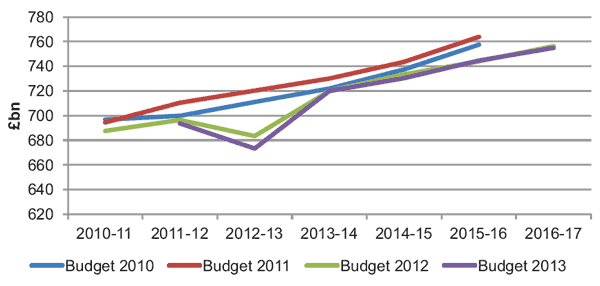
Forecast TME in successive budgets
The growth dilemma
Government spending as a proportion of GDP is dependent on two different forecasts – government spending, and GDP. The chart below shows how optimistic official GDP forecasts have been. The concerning thing is that even the forecasts from the 2013 Budget envisage Real GDP growth returning to over 2 per cent within 2 years. The government is still expecting a recovery, but more delayed.
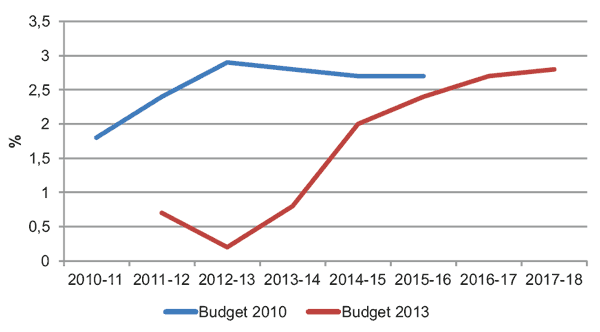
Real GDP Forecast
Thus far the steady decline forecast in 2010 has failed to materialise, with an increase in spending, even as a proportion of GDP, being projected for 2013/14 because of slow economic growth whilst government spending continues to rise. Once again the projected declines seem more likely the result of over optimistic growth forecasts than genuine cuts to spending. Rather than offer a plan to cut spending, the government’s hope was for the economy to reduce its debt burden through higher growth. As this future growth fails to materalise it becomes clearer that the original consolidation plans were growth-led, rather than led by reductions in government spending.
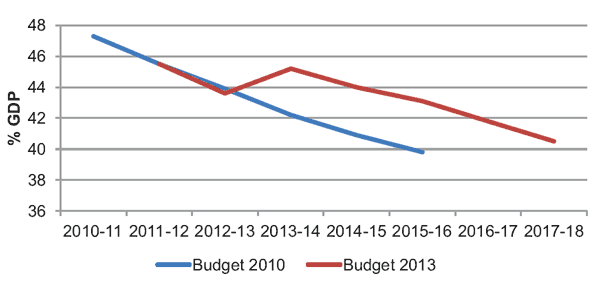
TME Forecast
Ringfencing cuts
The government has continued to ringfence the budget of the National Health Service (NHS) and given that this is the second largest part of government spending (after “social protection”) it means the planned cuts to Department Expenditure Limits (the part of current expenditure over which the government has most discretion) will be concentrated heavily on specific departments. From 2012/13 to 2014/15 Department Expenditure Limits for current spending are forecast to rise from £317.8bn to £323.6bn, with 10 departments receiving a rise and 12 a cut. The big losers are Local Government; Business, Innovation and Skills; and Defence. Over the same period spending limits for capital spending is expected to rise from £38.6bn to £46.9bn, with 14 departments having a rise and 4 having a fall. Depending on the measure of inflation being chosen some of the departments with nominal increases will receive real cuts.
Borrowing will rise
All of the above help to explain why the government’s plan to reduce borrowing has disappointed. In the 2010 Budget the government set out a clear plan to steadily reduce the size of the budget deficit. However, over the course of 2013, borrowing is now forecast to rise, only to begin falling from 2014 onwards and at a much slower pace.

Public Sector Net Borrowing
Commentators disagree on why growth has stalled, with some arguing that it is because the intended pace of consolidation was too harsh, some saying it was too cautious, others pointing to supply-side problems such as regulation and taxation, and others saying it is due to external events such as the euro zone crisis. But what we can conclude is the following:
– There has been more rhetoric about spending cuts than actual cuts in spending
– The completed part of the fiscal consolidation has focused on tax rises, not on spending cuts though tax revenues are still sluggish
– Proposed spending cuts as a proportion of national income have been exaggerated due to implausible growth forecasts.
